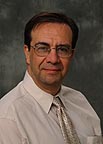December 14, 2006
Professor trying to add 'smarts' to computers
CARBONDALE, Ill. -- It happens thousands of times each day on the Southern Illinois University Carbondale campus.
Individuals hurrying to classes, offices and laboratories converge on an intersecting section of sidewalk. A collision appears imminent, but as they approach the intersection each of these busy individuals make tiny adjustments in their speed and direction and use various means to communicate their intended paths to each other. Usually, they successfully avoid crashing into each other.
An SIUC computer science professor is developing cutting-edge approaches aimed at helping machines behave in similar, cooperative ways, mimicking some of the more positive aspects of human behavior and society.
Since the 1980s, Henry Hexmoor has looked for ways to translate the complex social and psychological mechanics of the human experience into the stark "1s and 0s" language that runs computers and software. He applies these techniques to the study of artificial intelligence, robotics, computer simulation and control theory.
The essence of the work involves studying social theory and assigning numerical values to what humans would consider "emotions" or "values." Assigning values allows Hexmoor to build mathematical models that relate such concepts to machines.
"Much of what I do is parameterize social actions and attributes," said Hexmoor, who started teaching at SIUC this fall after six years at the University of Arkansas at Fayetteville. "There are rules that govern human society. We mimic those in computers."
Hexmoor wants to find ways to make multiple machines — called "agents" — share a single objective, but work independently and cooperatively to achieve it. One such experiment, for example, replicates the sidewalk dilemma, where several robotic agents are trying to pass through roughly the same space at about the same time. A video of the experiment shows the robots
heading toward one another from different parts of a room, but in the last seconds they manage to miss one another.
"We engineered them so that thousands of times per second they look at the situation and make changes," Hexmoor said. "In the end, they come up with a solution that's good for everyone."
Not surprisingly, perhaps, the U.S. Department of Defense has long held an interest in Hexmoor's work, as it readily applies to the complex issues at work in many theaters of combat where multiple "agents" seek to identify and engage multiple "targets." It also lends itself to the latest trends in military operations that emphasize off-site control of remote equipment, such as Predator unmanned aircraft.
Hexmoor has received about $2 million in research contracts over the years. Most recently, he received a $35,000 subcontract from the U.S. Air Force Research Laboratory to examine human control of a "community" of five robots. Hexmoor's SIUC students will assist in writing the software for the project, he said.
"We're trying to add smarts to the machines," Hexmoor explained, "so that they'll do the right things, the things we want them to do. We want to capture the spirit of what the humans want done and translate that to a machine."
To do so, Hexmoor draws on his keen interest in sociological and psychological theory. Books on those and many other subjects — such as some on "game theory"— line the walls of his office at Faner Hall. Coming up with new ideas, he explains, is a simple distilling process that starts with his reading a book about theory and then turning to daily news reports.
"I apply abstract theories to ongoing world issues," Hexmoor said. "When I read about these social and psychological theories, I think to myself, 'what is the math involved here?'"
His work also is applicable to many peacetime pursuits. For example, he was part of a team working for NASA on "personal satellite assistants" or PSAs. The small machines are designed to fly around a spacecraft, such as the International Space Station, and "sniff" for leaks. The machines work together, communicating in order to triangulate the location of any detected leak. NASA's Ames Research Center is testing the system.
Hexmoor earned a doctorate in computer science in 1996 from the University of Buffalo. He conducted graduate studies in artificial intelligence at the University of Georgia and in 1985 earned a master's degree in robotics at Georgia Institute of Technology. He earned a bachelor's degree in mechanical engineering in 1982 at the University of Stony Brook.
"SIUC is friendly, diverse campus and lovely place to raise a family," Hexmoor said.
Recruiting and retaining high-quality faculty is among the goals of Southern at 150: Building Excellence Through Commitment, the blueprint the University is following as it approaches its 150th anniversary in 2019.

Making ‘smart’ machines – Henry
Hexmoor, a professor in the
computer science department at
Southern Illinois University
Carbondale, along with graduate
students Kishore Thakur and
Gaurav Tuli, work as a team to
program their robots to deal
with complex problems by using
human ways of thinking. This
highly advanced robot has the
capacity to learn and teach
itself new problem-solving
techniques. Download Photo
Here

Henry Hexmoor
Download Photo Here
